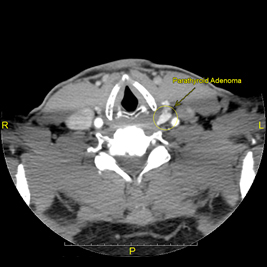Offering New Hope to Patients with Challenging Parathyroid Disease

| 4D-CT scan of the neck showing localized parathyroid tumor (adenoma) the size of a small olive, which was not detected in the prior ultrasound and SPECT-CT scans, as even glands this size are often missed with these imaging studies. |
Hyperparathyroidism is a condition causing high blood-calcium levels that afflicts about 100,000 Americans each year. It is caused by the overproduction of parathyroid hormone (PTH) by one or more of the four parathyroid glands located in the neck.
This chronic condition may result in kidney stones, osteoporosis, abdominal problems, fatigue, and depression, among other illnesses. It can successfully be treated by removing the abnormal parathyroid gland(s).
Surgery to remove abnormal parathyroid glands (parathyroidectomy) is indicated for moderate to severe symptoms of hyperparathyroidism. In cases where the problem is an adenoma (benign tumor), just the one gland will be removed.
If all four glands are enlarged (hyperplasia), the surgeon will likely remove most (three and a half) or all of them.
Surgical removal of abnormal glands results in a cure. Traditionally, the operation involved exploration of both sides of the neck through an incision of about 2-3 inches.
Unfortunately, the number and location of parathyroid glands can vary in individuals, and because of this, the traditional method of surgery was not always successful.
In the last two decades, technological developments in imaging plus the rapid PTH measurement obtained during the actual surgery have allowed surgeons to perform focused operations targeting preoperatively identified abnormal glands.
To locate a tumor or abnormal parathyroid gland prior to surgery, a variety of imaging methods are used, including ultrasound, magnetic resonance imaging (MRI), and radioactive isotope sestamibi scan (the isotope is absorbed only by the overactive gland, not healthy ones).
These imaging methods effectively locate around 95% of abnormal glands, but the remaining 5% of cases need to be addressed.

At Stony Brook Medicine, we have added to our set of imaging tools the latest technology in parathyroid imaging, called four-dimensional computed tomography (CT), or 4D-CT, to improve the treatment we provide for hyperparathyroidism.
The resolution of 4D-CT imaging is higher than that of any other type of parathyroid scan. In fact, it can identify abnormal parathyroid glands as small as 1/32 inch x 1/4 inch, that is, around the size of a tiny lentil.
The patient is given intravenous contrast (iodine-based dye) to enhance the quality of the imaging. Images are then acquired with the CT scanner at very specific times when the contrast is maximally taken up by the parathyroid glands.
The "fourth dimension" is time, and in 4D-CT a three-dimensional CT volume containing a structure of interest — the patient's neck — is imaged over a period of time while injected contrast material moves through the tissues, creating a dynamic volume data set.
Parathyroid 4D-CT offers a new level of precision in localizing abnormal glands, and also provides an increased sense of security for patients going into surgery.
This data set is then analyzed by the radiologist and surgeon to locate abnormal parathyroid glands.
Commenting on the value of 4D-CT imaging, our new head and neck surgeon Lukasz Czerwonka, MD, assistant professor of surgery, says:
"Parathyroid 4D-CT is especially useful when other imaging studies fail to detect or locate abnormal glands, and when patients have a history of prior failed parathyroid surgery.
"In these patients, the fine resolution provided by 4D-CT helps us to minimize our surgery, which not only increases the chance for a cure but also reduces the risk of surgical complications.
"Ultrasound and sestamibi are still the basic imaging studies used to detect abnormal parathyroid glands. If these tests are able to localize the abnormal gland, there is generally no need for additional imaging.
"But when we treat patients with challenging cases of hyperparathyroidism, 4D-CT is a really valuable imaging tool, as it helps the surgery tremendously."
Together with the imaging precision of 4D-CT, the minimally invasive procedure our head and surgeons generally use for the treatment of hyperparathyroidism offers patients many benefits, and for those patients whose operations in the past have failed, it can offer them new hope.
More than a decade ago, our surgeons started performing a then-new technique called minimally invasive parathyroidectomy (MIP) which offers a safer and less invasive approach.
Using the latest imaging technology and the most advanced surgical procedure, our head and neck/endocrine surgeons provide the highest level of care.
Since 85% to 90% of patients with hyperparathyroidism have a single parathyroid adenoma and its removal generally results in cure, our ability to determine before surgery the location of the abnormal gland makes a directed operation the most logical approach to treatment.
The entire MIP procedure can usually be performed through a small (about 1-inch) incision in the neck. It generally takes less than an hour.
Once the abnormal parathyroid gland has been removed, a blood sample is drawn from the patient and sent for rapid assay of PTH. Stony Brook Medicine’s special laboratory services can provide the results within half an hour.
A drop in the level of the hormone to normal or near-normal range helps the surgeon be confident that the operation is complete — that is, whether or not another "normal" gland will need to be removed.
It is generally not necessary to perform more extensive exploration to find any other parathyroid glands, and this avoidance of further exploration minimizes the risk of surgical complications.
Using the latest imaging technology and the most advanced surgical procedure, our head and neck/endocrine surgeons provide the highest level of care for patients with parathyroid disease, even for those whose cases could not be treated successfully elsewhere.
| "4D-CT provides significantly greater sensitivity than sestamibi imaging and ultrasonography for precise (quadrant) localization of hyperfunctioning parathyroid glands. This allows improved preoperative planning, particularly for the case of reoperation." — Rodgers SE, Hunter GJ, Hamberg LM, et al. Improved preoperative planning for directed parathyroidectomy with 4-dimensional computed tomography. Surgery. |


